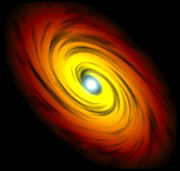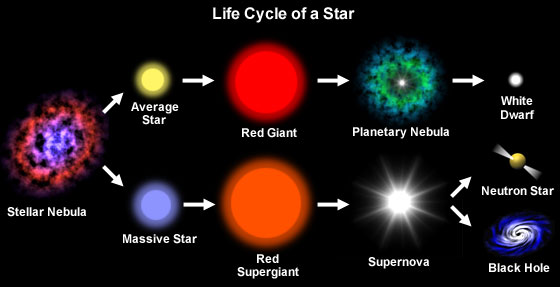

For eons, mankind has looked to the heavens and wondered at the lights in the sky. Ancient people believed they could see shapes among the stars. They identified both animals and people, and each had its own story. These chance alignments of the stars are known as constellations. Today, the 88 constellations are used by astronomers to organize the night sky and to identify the locations of the stars. Stars are the most plentiful objects in the visible universe. They provide the light and energy that fuels a solar system. They also create the heavy elements that are necessary to form life. Without stars, there would be no life. The Sun provides energy for nearly every living thing on Earth. It also warms our planet's surface to create a virtual oasis in the coldness of space. A star's brightness is known as its magnitude. Astronomers rate the magnitude of a star with a scale that gives brighter stars a low number and dim stars a higher number. Each whole number on this scale is 2.5 times dimmer than the previous number. The brightest star in the night sky is Sirius. With a magnitude of -1.46, it is almost 15 times brighter than a star with a magnitude of zero. Stars with a magnitude of 8 or more are too dim to see with the naked eye. Stars are identified by their color, which indicates their temperature. They are divided into what are known as spectral classes. These classes are O, B, A, F, G, K, and M. Class O stars are the hottest and are blue in color. The coolest stars are identified as class M and are red in color.

Contrary to popular belief, stars do not actually twinkle. This phenomenon is a result of atmospheric interference. The effect is similar to what takes place on a hot summer day when you look across hot pavement or a parking lot. The rising air causes images to waver. This is what causes the twinkling effect in stars. The lower a star is in the sky, the more it will twinkle because its light must pass through more of the atmosphere.

A star is like a gigantic nuclear furnace. The nuclear reactions inside convert hydrogen into helium by means of a process known as fusion. It is this nuclear reaction that gives a star its energy. Fusion takes place when the nuclei of hydrogen atoms with one proton each fuse together to form helium atoms with two protons. A standard hydrogen atom has one proton in its nucleus. There are two isotopes of hydrogen, which also contain one proton, but contain neutrons as well. Deuterium contains one neutron while Tritium contains two. Deep within the star, A deuterium atom combines with a tritium atom. This forms a helium atom and an extra neutron. In the process, an incredible amount of energy is released. When the star's supply of hydrogen is used up, it begins to convert helium into oxygen and carbon. If the star is massive enough, it will continue until it converts carbon and oxygen into neon, sodium, magnesium, sulfur and silicon. Eventually, these elements are transformed into calcium, iron, nickel, chromium, copper and others until iron is formed. When the core becomes primarily iron, the star's nuclear reaction can no longer continue. This is because the temperature required to fuse iron is much too great. The inward pressure of gravity becomes stronger than the outward pressure of the nuclear reaction. The star collapses in on itself. What happens next depends on the star's original mass.

Stars begin their lives as clouds of dust and gas called nebulae. The gravity of a passing star or the shock wave from a nearby supernova may cause the nebula to contract. Matter in the gas cloud will begin to coalesce into a dense region called a protostar. As the protostar continues to condense, it heats up. Eventually, it reaches a critical mass and nuclear fusion begins. This begins the main sequence phase of the star. It will spend most of its life in this stable phase. The life span of a star depends on its size. Very large, massive stars burn their fuel much faster than smaller stars. Their main sequence may last only a few hundred thousand years. Smaller stars will live on for billions of years because they burn their fuel much more slowly. Eventually, the star's fuel will begin to run out. It will expand into what is known as a red giant. Massive stars will become red supergiants. This phase will last until the star exhausts its remaining fuel. At this point, the pressure of the nuclear reaction is not strong enough to equalize the force of gravity and the star will collapse. Most average stars will blow away their outer atmospheres to form a planetary nebula. Their cores will remain behind and burn as a white dwarf until they cool down. What will be left is a dark ball of matter known as a black dwarf. If the star is massive enough, the collapse will trigger a violent explosion known as a supernova. If the remaining mass of the star is about 1.4 times that of our Sun, the core is unable to support itself and it will collapse further to become a neutron star. The matter inside the star will be compressed so tightly that its atoms are compacted into a dense shell of neutrons. If the remaining mass of the star is more than about three times that of the Sun, it will collapse so completely that it will literally disappear from the universe. What is left behind is an intense region of gravity called a black hole.

The nebula that was expelled from the star may continue to expand for millions of years. Eventually, the gravity of a passing star or the shock wave from a nearby supernova may cause it to contract, starting the entire process all over again. This process repeats itself throughout the universe in an endless cycle of birth, death, and rebirth. It is this cycle of stellar evolution that produces all of the heavy elements required for life. Our solar system formed from such a second or third generation nebula, leaving an abundance of heavy elements here on Earth and throughout the Solar System. This means that We are all made of star stuff. Every atom in our bodies was created either in the nuclear furnace of a star or in the cataclysmic explosion of a supernovas.
A star is like a gigantic nuclear furnace. The nuclear reactions inside convert hydrogen into helium by means of a process known as fusion. It is this nuclear reaction that gives a star its energy. Fusion takes place when the nuclei of hydrogen atoms with one proton each fuse together to form helium atoms with two protons. A standard hydrogen atom has one proton in its nucleus. There are two isotopes of hydrogen, which also contain one proton, but contain neutrons as well. Deuterium contains one neutron while Tritium contains two. Deep within the star, A deuterium atom combines with a tritium atom. This forms a helium atom and an extra neutron. In the process, an incredible amount of energy is released. When the star's supply of hydrogen is used up, it begins to convert helium into oxygen and carbon. If the star is massive enough, it will continue until it converts carbon and oxygen into neon, sodium, magnesium, sulfur and silicon. Eventually, these elements are transformed into calcium, iron, nickel, chromium, copper and others until iron is formed. When the core becomes primarily iron, the star's nuclear reaction can no longer continue. This is because the temperature required to fuse iron is much too great. The inward pressure of gravity becomes stronger than the outward pressure of the nuclear reaction. The star collapses in on itself. What happens next depends on the star's original mass.
Main Sequence Stars - The main sequence is the point in a star's evolution during which it maintains a stable nuclear reaction. It is this stage during which a star will spend most of its life. Our Sun is a main sequence star. A main sequence star will experience only small fluctuations in luminosity and temperature. The amount of time a star spends in this phase depends on its mass. Large, massive stars will have a short main sequence stage while less massive stars will remain in main sequence much longer. Very massive stars will exhaust their fuel in only a few hundred million years. Smaller stars, like the Sun, will burn for several billion years during their main sequence stage. Very massive stars will become blue giants during their main sequence. |
 |
Red Giants - A red giant is a large star that is reddish or orange in color. It represents the late phase of development in a star's life, when its supply hydrogen has been exhausted and helium is being fused. This causes the star to collapse, raising the temperature in the core. The outer surface of the star expands and cools, giving it a reddish color. Red giants are very large, reaching sizes of over 100 times the star's original size. Very large stars will form what are called red supergiants. Betelgeuse in Orion is an example of a red supergiant star. |
 |
White Dwarfs - A white dwarf is the remnant of an average-sized star that has passed through the red giant stage of its life. After the star has used up its remaining fuel. At this point the star may expel some of its matter into space, creating a planetary nebula. What remains is the dead core of the star. Nuclear fusion no longer takes place. The core glows because of its residual heat. Eventually the core will radiate all of its heat into space and cool down to become what is known as a black dwarf. White dwarf stars are very dense. Their size is about the same as that of the Earth, but the contain as much mass as the Sun. They are extremely hot, reaching temperatures of over 100,000 degrees. |
 |
Brown Dwarfs - A brown dwarf could also be called a failed star. During the process of star formation, some protostars never reach the critical mass required to ignite the fires of nuclear fusion. If the protostar's mass is only about 1/10 that of the Sun, it will glow only briefly until its energy dies out. What remains is a brown dwarf. It is a giant ball of gas that is too massive to be a planet but not massive enough to be a star. They are smaller than the Sun but several times larger than the planet Jupiter. Brown dwarfs emit no light or heat. They could account for some of the dark matter suspected to exist in the universe. |
 |
Variable Stars - A variable star is a star that changes in brightness. These fluctuations can range from seconds to years depending on the type of variable star. Stars usually change their brightness when they are young and when they are old and dying. They are classified as either intrinsic or extrinsic. Intrinsic variables change their brightness because of conditions within the stars themselves. Extrinsic variables change brightness because of some external factor, like an orbiting companion star. These are also known as eclipsing binaries. |
 |
Binary Stars - Many stars in the universe are part of a multiple star system. A binary star is a system of two stars that are gravitationally bound to each other. They orbit around a common point, called the center of mass. It is estimated that about half of all the stars in our galaxy are part of a binary system. Visual binaries can be seen as two separate stars through a telescope. Spectroscopic binaries appear as one star and can only be detected by studying the Doppler shifts on the star's spectrum. Eclipsing binaries are binary systems where one star blocks the light from another as it orbits its companion. |
 |
Stars | Planets | Moons | Asteroids-Comets | Nebulae | Star Clusters
Galaxies | Pulsars | Quasars | Black Holes | Dark Matter